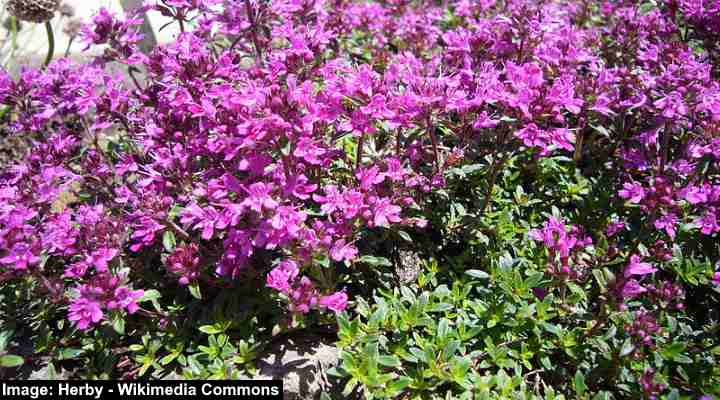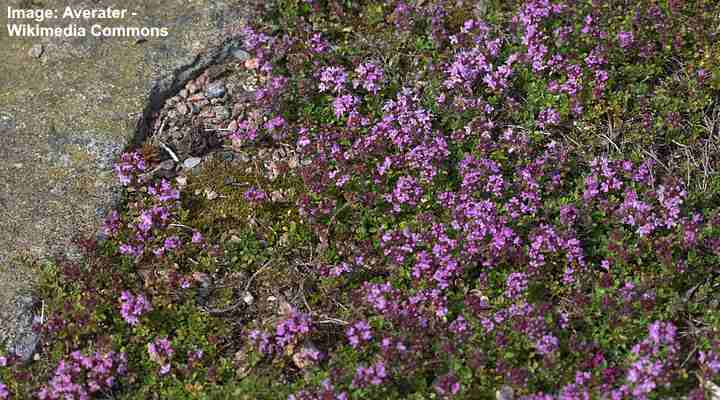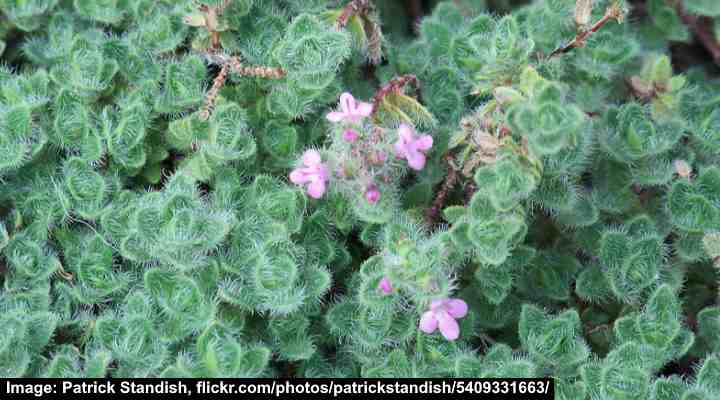Creeping Thyme Lawn: Types, Advantages and Care

A creeping thyme lawn is an excellent alternative to a traditional lawn. Planting low-growing creeping thyme as a lawn substitute is easier to maintain and requires less watering. Additionally, creeping thyme transforms your yard every summer with a blanket of pink, purple or magenta-red flowers — something a typical lawn can never do. Also, a creeping thyme lawn thrives in full sun and doesn’t suffer sun scorch like traditional turfgrass.
Creeping thyme is one of the many plants suitable as a lawn alternative. The fast-spreading creeping plant quickly takes root in the soil, and its evergreen foliage stays green throughout the year. Because it’s ideal for xeriscaping, creeping thyme is a popular plant to grow in place of traditional lawn grasses.
What is it about creeping thyme lawn that makes it so popular as an evergreen ground cover plant in place of a lawn? Is it easy to maintain a creeping thyme lawn? And how can you replace your existing lawn with creeping thyme? This article answers these questions and more.
What is Creeping Thyme Lawn?
A creeping thyme lawn is a superb alternative to turfgrass. Varieties of low-growing thyme like red creeping thyme Thymus serpyllum ‘Coccineus’ only grow 2 to 3 inches (5 – 7.5 cm) tall. Their spreading nature means ground cover thyme plants form a carpet of lush green foliage that requires little maintenance.
But why look for a lawn alternative? Why not just keep maintaining your existing turfgrass to enhance the aesthetics of your property?
It’s good to remember that lawns aren’t just for appearance. Maintaining a lush, healthy lawn is good for the environment.
For example, a lawn reduces hard surfaces like brick paving and concrete in your yard. In addition, the evergreen vegetation does a vital job of cleaning the air, trapping carbon dioxide, preventing soil erosion, lowering noise levels, and reducing temperatures.
However, maintaining a turfgrass lawn can be expensive. For example, it takes 0.62 gallons per square foot weekly to keep your lawn healthy and green. Therefore, looking for a lawn substitute is a good idea. This is especially true if you maintain a lawn in southern states like Florida.
Creeping thyme is the ideal alternative to a turf lawn. The low-spreading, flowering plant does everything a typical lawn should do. It traps CO2, reduces noise, prevents water runoff, and cleans the air. However, because it’s drought tolerant and thrives in full sun, creeping thyme lawn uses few resources to maintain.
Types of Creeping Thyme Lawn
Plants suitable for growing a creeping thyme lawn should only grow a few inches tall, withstand moderate foot traffic, and take little time to maintain. So what are the best creeping thyme varieties you can grow instead of turfgrass? Here are four varieties of creeping thyme lawn plants.
Red Creeping Thyme Lawn (Thymus serpyllum ‘Coccineus’)

Red creeping thyme lawn (Thymus serpyllum ‘Coccineus’) has small deep magenta colored flowers
Red creeping thyme is a popular lawn alternative because of its low-growth habit, evergreen foliage, and deep reddish-pink flowers. Red creeping thyme lawns grow up to 3” (7.5 cm) tall and spread a wide distance when the stems root in the soil. The deep pink flowers bloom throughout summer.
Red creeping time is also an attractive red-flowering ground cover plant. The horizontally spreading stems prevent soil erosion and weed growth. They are covered in tiny evergreen or semi-evergreen oval leaves. Additionally, the tiny pink tubular flowers bloom in mass, creating a sea of reddish colors.
Purple Creeping Thyme Lawn (Thymus serpyllum)

Purple creeping thyme is a low growing perennial ground cover plant with purple-pink flowers that thrive in full sun
A purple creeping thyme lawn is an attractive carpet of glossy dark green leaves and aromatic purple flowers. The purple flowers on this ground cover plant are small, attractive, star-shaped blooms. As an aromatic lawn, purple creeping thyme emits minty aromas when you walk on it.
Like most creeping thyme species, this fast-growing ground cover plant grows 2” to 3” (5 – 7.5 cm) tall and spreads by rooting stems in the soil.
Pink Creeping Thyme Lawn (Thymus serpyllum ‘Elfin’)

Elfin creeping thyme is suitable for poor soils and is a low-maintenance easy to care for ground cover
The Thymus serpyllum Elfin cultivar is an ideal pink creeping thyme lawn. Elfin thyme is a low-spreading plant with fragrant, glossy green oval leaves and abundant pinkish-purple flowers that create a mat of beautiful colors in summer. This creeping thyme lawn plant grows 1” to 3” (2.5 – 7.5 cm) tall and spreads fast.
Woolly Creeping Thyme Lawn (Thymus pseudolanuginosus)

Creeping woolly thyme is a mat-forming ground cover plant with fuzzy leaves and pale pink flowers
Woolly creeping thyme is a pink-flowering ground cover plant with features suitable for a lawn alternative. The creeping thyme variety is identified by its fuzzy leaves with a minty rosemary aroma. In addition, the flowering lawn plant has pale pink flowers and only grows 3” (7.5 cm) tall.
Further reading: Types of Creeping Thyme.
The Benefits of Creeping Thyme Lawn
Creeping thyme is a great choice for replacing grass because it will grow quickly without needing much maintenance. Creeping thyme doesn’t require much watering, fertilizer, or mowing. Other benefits of this creeping flowering plant include its ability to withstand light foot traffic and improve your yard’s appearance.
Here are seven benefits of growing a creeping thyme lawn in your front or backyard:
Creeping thyme is an excellent flowering ground cover
Red creeping thyme and other creeping thyme varieties don’t grow taller than 3” (7.5 cm), making them excellent ground cover plants. Its medium growth rate and spreading nature mean it sprawls over bare ground without becoming invasive. Thanks to its evergreen foliage, the herbaceous spreading plant keeps yards looking lush all year.
Creeping thyme lawn doesn’t require mowing
All varieties of creeping thyme suitable for a lawn substitute require almost no mowing. The sprawling plant has a naturally low height, meaning you don’t need to push a lawnmower over it. In addition, creeping thyme creates a low-maintenance lawn that prevents weed growth.
However, you can decide to mow the creeping thyme lawn once a year. Even though the plant is a woody perennial, the woody, spreading stems won’t affect a mower if you decide to trim it. Mowing after flowering can encourage bushy growth and a wider spread.
Creeping thyme lawn has aromatic leaves and flowers
One benefit of planting a creeping thyme lawn is to fill your yard with pleasant aromas. Thyme is an herbaceous plant and a member of the mint family Lamiaceae. Walking over a creeping thyme lawn releases essential oils, giving off a pleasant minty fragrance. Additionally, you can use thyme leaves to flavor food.
Creeping thyme lawn withstands foot traffic
Red creeping thyme, woolly thyme, and other creeping thyme varieties make excellent lawn alternatives because they create walkable ground cover solutions. The woody stems of creeping thyme bounce back under light to moderate foot traffic without showing signs of wear and tear. Additionally, its drought tolerance creates a highly resilient lawn.
Creeping thyme lawn requires less water than turfgrass
Do you want a robust green lawn without the need to water it frequently? If so, creeping thyme ground cover plants are the answer. A creeping thyme lawn needs a fraction of the water traditional lawns require. Therefore, even in hot, sunny weather, thyme lawns don’t show signs of stress, turn brown, or die off.
Creeping thyme lawn is ideal for xeriscaping
Growing a creeping thyme lawn is perfect for planting in a xeric garden where water conservation is crucial. After being established, creeping thyme plants require little more than natural rainfall to thrive if the soil is well-draining. In fact, the quality of the essential oils improves in drought conditions.
Creeping thyme lawn is deer resistant
Planting a creeping thyme lawn is perfect if deer are a problem in your area. Deer tend to stay clear of creeping thyme and will search out tastier treats. So, the good news with this lawn substitute plant is that it is rarely on a deer’s menu.
Related reading: Top tips on keeping deer out of your yard.
Disadvantages of Creeping Thyme Lawn
Despite the benefits of a creeping thyme lawn, it has some drawbacks. For example, thyme ground cover plants require full sun and well-drained soil. Therefore, not all areas of your yard may be suitable for this lawn alternative. So, what are the other considerations when growing a creeping thyme lawn?
Creeping thyme lawn can be expensive
Cost is the most significant drawback of planting a creeping thyme lawn instead of traditional turfgrass. Buying thyme seedlings can be more expensive than laying grass seeds. And thyme seed is challenging to germinate. Therefore, the best solution is to start with a small area and allow the thyme to spread year after year.
Creeping thyme lawn doesn’t grow well in the shade
Growing a creeping thyme lawn isn’t practical if your yard is in the shade. Even in partial shade, creeping thyme doesn’t thrive. Instead, its woody stems become leggy and sparse with vegetation. Additionally, thyme growing in the shade is susceptible to pests and weeds.
Related reading: Ground cover plants for the shade.
Creeping thyme lawn requires well-draining soil
A disadvantage of using creeping thyme plants as a substitute for a turfgrass lawn is that the plant requires excellent drainage. Thyme roots are prone to root rot if the ground is too wet or soggy. Overly damp soil can end up killing the ground cover plant.
Creeping thyme lawn is harder to install than a traditional grass lawn
Unfortunately, creeping thyme lawns take more time to install. Therefore, they are not quick-fix lawn replacements. The spreading plant will take a few years to create dense evergreen ground cover. And, it is impossible to purchase rolls of ready-to-install thyme lawns to transform your yard instantly.
Creeping thyme lawn attracts pollinators
Although attracting pollinators to your yard is generally a positive thing, masses of purple flowers throughout the summer can attract too many bees. Therefore, depending on the size of your lawn and tolerance for flying, stinging insects, a creeping thyme lawn may not be for you.
Creeping Thyme Lawn vs. Traditional Lawn
Creeping thyme lawns require less water than typical turfgrass lawns. Therefore, the lawn alternative is more resilient in hot weather, and its evergreen foliage won’t go brown like typical grass in hot weather. Additionally, a creeping thyme lawn provides an abundance of purple, reddish, and pink flowers in a summer landscape, unlike traditional lawns.
How to Plant a Creeping Thyme Lawn
Although an aromatic creeping thyme lawn requires more effort to install than laying traditional sod, it is not difficult, and the results are worth it. In addition, once established, a creeping thyme lawn takes less maintenance and resources than keeping a traditional lawn looking lush, healthy, and green.
To replace an existing lawn, you must remove the turf grass. The easiest way to get rid of an existing lawn is to cover the existing grass with cardboard and mulch for one season. This kills the grass, and you can plant creeping thyme plants directly in the ground the following season.
The other, faster option to replace a traditional lawn with a creeping thyme lawn in one season is to remove the grass physically. Next, till the soil to remove large items like roots, rocks, and debris. Finally, to get the soil ready for planting, amend it with bone meal to increase the nutrient content.
Once the soil is ready for planting in early spring, you can plant thyme plugs 8” (20 cm) apart and water thoroughly. As creeping thyme grows, it will spread horizontally, eventually filling the gaps and creating a new, low-maintenance lawn. You will need to water the ground frequently for the first few months to help establish the roots.
During the first year, expect the thyme plant to grow slowly. However, its growth rate speeds up in subsequent years.
How to Care for a Creeping Thyme Lawn
Although a creeping thyme lawn is relatively straightforward to care for, there are some things to keep in mind. For example, the low-growing ground cover plant requires plenty of sunshine and relatively dry conditions to thrive. Also, you must ensure water doesn’t pool on the lawn.
Here are some top tips on caring for creeping thyme plants that grow as a lawn alternative:
How to water creeping thyme lawn: Creeping thyme lawns are relatively resistant to drought. However, you shouldn’t allow the ground to get parched. Therefore, in the hottest, sunniest months water when there has been no rainfall, water the lawn when the top 3” (7.5 cm) of topsoil is dry.
It’s good to remember that in most conditions in USDA zones 4 to 9, established creeping thyme lawns get by on regular rainfall without additional watering.
Pruning a creeping thyme lawn: The way to prune a creeping thyme lawn is by using your lawnmower. Set the blade at the highest or around 4” (10 cm). Then mow the thyme lawn in rows, taking care not to make more than one pass. Lastly, you can use a light, flexible rake to remove cut foliage from the surface.
It’s good to remember that pruning or mowing a creeping thyme lawn is not a requirement. However, lightly mowing the lawn in early spring and late fall can encourage healthy growth and abundant blooming.
Creeping thyme lawn fertilizer: Creeping thyme lawns don’t require fertilizing. One of the benefits of growing creeping thyme for ground cover is that it adapts well to poor soils. This is one of the ways that adding a creeping thyme lawn to your landscape saves resources and benefits your garden’s ecosystem.
Does a Creeping Thyme Lawn Require Mowing?
By growing a creeping thyme lawn in your front or backyard, you can say goodbye to arduous lawn mowing. The maximum height of creeping thyme is 2” to 3” (5 – 7.5 cm). According to Michigan State University researchers, this is the same recommended height for standard turfgrass. Researchers say that taller grass reduces stress and helps suppress weed growth.
Related articles:
- Types of Creeping Thyme – Identification Guide
- Red Creeping Thyme – Identification and Growing Guide
- Lemon Thyme: Care and Growing Guide
